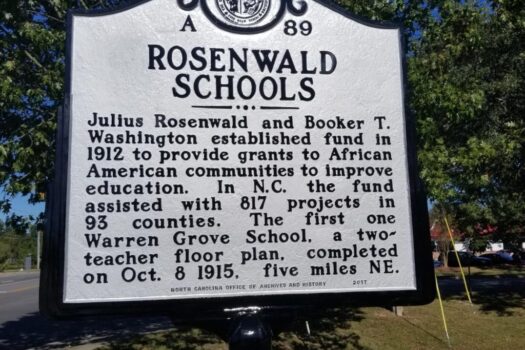…What Can We Learn From it Today?
In the early 20th century, a transformative movement quietly took root in America’s rural South, shaping the educational and economic future of African American families.
This movement centered around the Rosenwald Schools, modest one-, two-, and three-teacher buildings that exclusively served over 700,000 Black children between 1917 and 1932.
A historical marker along NC 32 south near Luke Street in Edenton commemorates the first Rosenwald School in North Carolina. Credit: NC Department of Natural and Cultural Resources
These nearly 5,000 rural schoolhouses emerged from an unexpected collaboration between two visionaries: Booker T. Washington, an influential educator and African American thought leader, and Julius Rosenwald, a German-Jewish immigrant who amassed wealth as the head of Sears, Roebuck & Company.
In 1912, Rosenwald donated $25,000 to aid Black colleges and preparatory academies. Washington proposed using a portion of these funds to build rural elementary schools in Black communities.
Project lead Alec Greenwald and students discuss their efforts to map a 20th century educational experiment across the Black Belt region of North Carolina. Video by Wil Weldon.
Over the next two decades, Rosenwald Schools sprouted across the South. The Rosenwald program significantly boosted literacy rates and school attendance among rural Southern Blacks. Students who attended these schools received a better education, leading to increased years of schooling.
The Rosenwald program trained a generation of future civil rights leaders, including Maya Angelou, Medgar Evers, John Lewis, and members of the Little Rock Nine.
In partnership with the Southeast Regional Coalition for University-Assisted Community Schools and the North Carolina Community Schools Coalition, this 2024 Data+ project aims to map the Rosenwald Schools across North Carolina’s Black Belt region. By understanding their historic assets and resource disparities, this data can inform how the Rosenwald community school model can help schools maximize the success of students today.
Writing by Ariel Dawn; video by Wil Weldon









